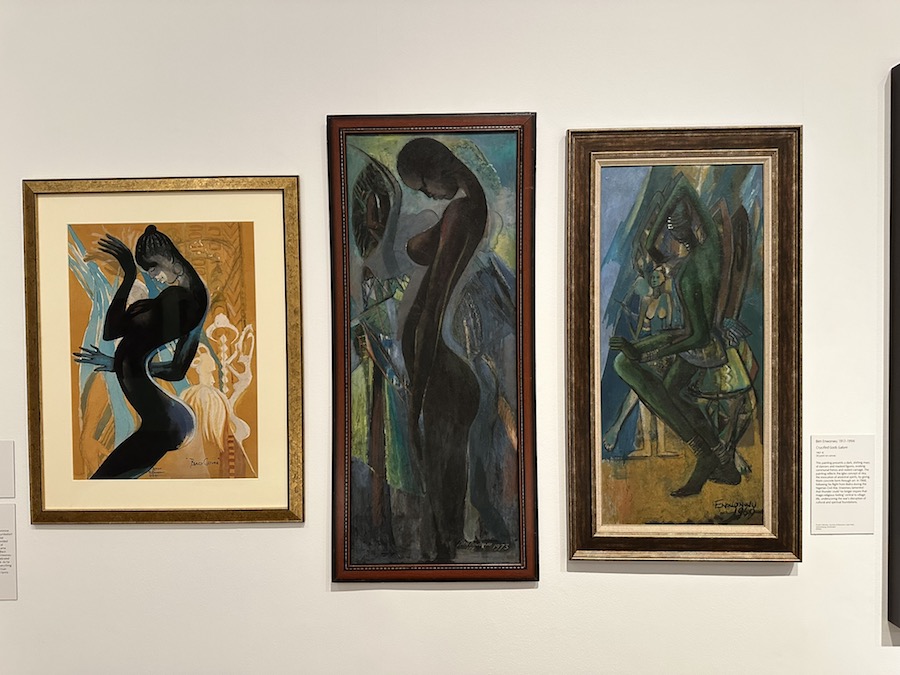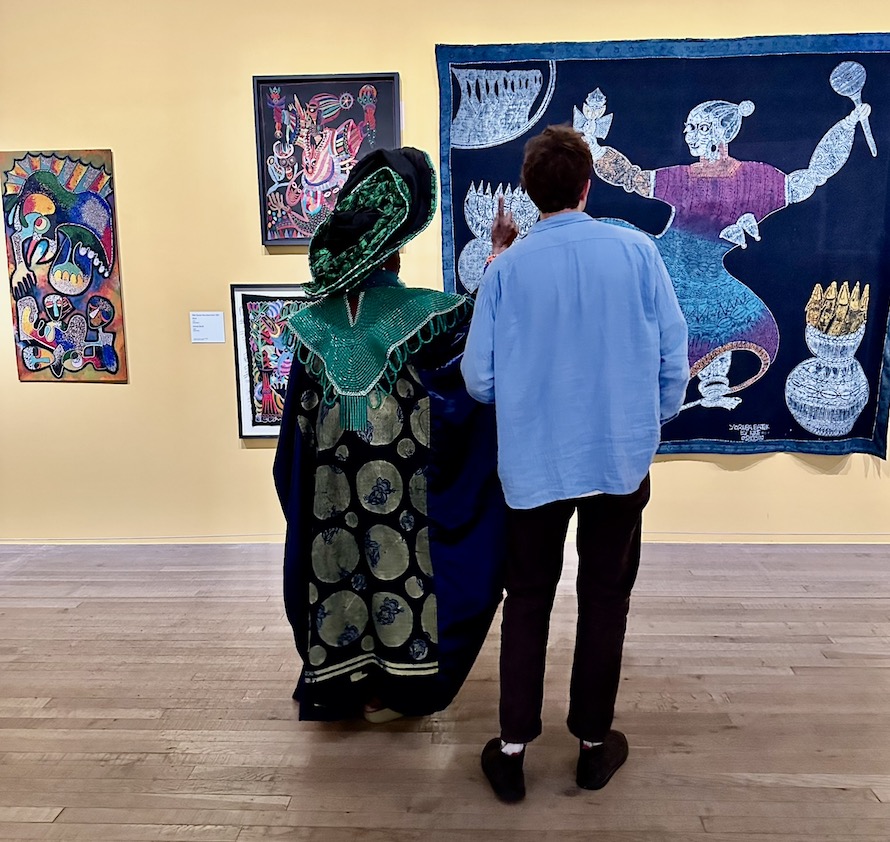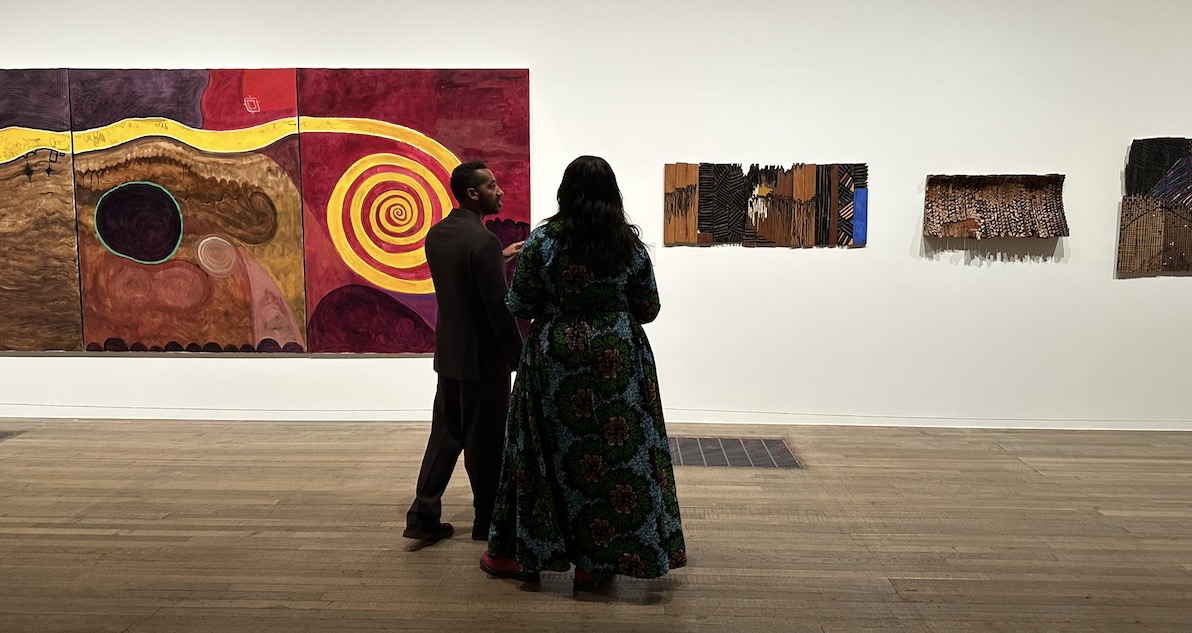The Nigerian Modernism exhibition at Tate Modern is massive. With work by over 50 artists from across 50 years to be displayed, the curators faced a dilemma as to how present so much from so many. Their solution was to focus on key individuals and key groups, from Ben Enwonwu to Uzo Egonu, and from the Zaria Art Society to the Nsukka School.
The first exhibition review I had published in 1985 was on ‘Rhythms of Hunger’ by Obiora Udechukwu at the Commonwealth Institute. Udechukwu was “one of the most important figures to emerge from the Nsukka School” and it is a pleasure to be reacquainted with his work. Similarly, to note the significance of the Commonwealth Institute which, in the wake of Nigerian independence, “became a venue for presenting Nigeria’s arts and culture to British and international audiences”. From the mid-1960s, the Institute’s art gallery staged significant Nigerian exhibitions, featuring modernists such as Clara Ugbodago-Ngu, Jimo Akola, Yusuf Grillo, Egonu, as well as Udechukwu.

The Commonwealth Institute “attempted to navigate the complexities of decolonisation, recasting itself as a platform for mutual exchange”. Navigating the complexities of colonisation and its legacies has been central to the development of Nigerian modernism. This is made clear in the exhibition’s opening statement: “Nigerian modernism was not a single movement, but a variety of responses to the country’s shifting cultural and political identity … artists were influenced by Pan-Africanism and European art forms. They also drew inspiration from local cultures. Artistic and religious traditions from the regions many ethnic groups – including Fulani-Hausa, Igbo and Yoruba people – met Christian and Islamic practices.” The resulting creative and vibrant mix is what is explored here.
The challenges involved in navigating these complexities are set out in the comparison of two early figures, Aina Onabolu, who trained many early Nigerian modernists in European forms of representation, and Akinọla Laṣekan, who became known for “his royal portraits, cultural rituals, and mythical heroes from Yoruba legends”. Ben Enwonwu, who followed both, combined both approaches but, as Osei Bonsu notes, for some, came to be seen “as a product of a split personality, a modern African artist at the crossroads of competing identities”.
Another example of these challenges is found in the role of Christian mission churches and schools which, in some instances such as Father Kevin Carroll’s workshop in Oye-Ekiti, included art workshops that provided training to other of Nigeria’s early modernists. Bonsu explains that the British administration “grew increasingly wary of the Christian mission’s … believing [they] fostered critical thinking and political dissent among Africans”. Yet, because the missions “encouraged the depiction of Christian Stories”, they opened themselves to ethical concerns related to cultural appropriation, religious imposition, and the commercialization of indigenous art. Nevertheless, they helped preserve and promote traditional craftsmanship and provided opportunities for artists like Lamidi Olonade Fakeye, whose work is included here.
From this base, each room of the exhibition highlights different artists, societies and schools who carved independent visions for what modern art in Nigeria could be. The first of these, The Zaria Art Society understood the issues and challenges to a significant extent and developed the concept of ‘natural synthesis’ as a result. These artists, including Bruce Onobrakpeya, Uche Okeke, Yusuf Grillo and Demas Nwoko, began, as Bonsu explains, calling “for the merging of the best of indigenous traditions and forms with useful Western ones”. The members of the group took the concept of ‘natural synthesis’ in many different directions over the course of their careers. Still, it, essentially, became the foundation for much of the work that has been brought together for this exhibition.
As a result, spirituality features strongly in the work of many of the artists and groups found here. Onobrakpeya, who is a practising Anglican although he worked for many years at a Catholic Boys School in Lagos, combined Biblical themes with the visual and oral traditions of the Urhobo and Yoruba peoples. At the request of Fr Carroll, he created a set of prints of the Stations of the Cross which reimagines the stories set in Nigerian contexts. Later, he recreated these in his signature plastograph style as surrounds to a central image of The Last Supper. This plastograph image plus a set of the Stations of the Cross prints form an arresting group of works in the room dedicated to the Zaria Art Society.

The Mbari Club in Ibadan, named by the writer Chinua Achebe after an Igbo word meaning a shrine dedicated to Ala, brought artists and writers together to “articulate a new vision of modernism in the postcolonial era”. Exhibitions organised through the Club brought together artists from Africa, Asia, South America, Europe and the US. At the same time, exterior murals at its base, by Okeke, were Igbo uli designs celebrating the dialogue between indigenous traditions and contemporary art. Other branches of Mbari were later formed at Enugu and Osogbo.
Ulli Beier, a German publisher and collector, and his wife, the Austrian artist Susanne Wenger, worked in partnership with Nigerian artists and writers to set up the Mbari Club. When Wenger moved to Osogbo in 1958, as a priestess of Obatala and a member of the Ogboni cult, she was approached by Yoruba priests asking for help in preserving the sacred groves of Osun. The art workshops Wenger initiated nurtured the talents of local tradespeople and skilled artisans creating a New Sacred Art Movement which, through restoration of Osun Grove, was dedicated to the Yoruba religion. The work of the Osogbo artists was rooted in traditional crafts including batik, metalwork, and wood carving, but showed the influence of German Expressionist techniques.
Okeke, whose work and influence, runs through much of this exhibition, was later appointed Head of the Department of Fine and Applied Arts at the University of Nigeria, Nsukka, from where the Nsukka School derives. Okeke organised the Nsukka’s art programme around the idea of ‘natural synthesis’ and formed a movement known for reviving uli, “an innovative Igbo female body and wall painting practice”. This brings us back to Udechukwu who, as Bonsu states, “found in uli limitless potential for social commentary and poetry: a visual language that could convey the philosophical and socio-political aspects of war and its aftermath”.
From the ink and wash drawings that I first saw at the Commonwealth Institute, in which figures are linked through fluid lines, to a large colour-filled work like ‘Our Journey’, where a flowing yellow line symbolising the sacred python – our divine guide through the coloured emotions of our life stages – Udechukwu layers traditional ritual on contemporary events.
The exhibition ends with the work of Egonu, a diaspora artist who relocated from Nigeria to the UK as a teenager at the end of World War II. His ‘Stateless People’ series depicts artists – musician, writer, visual artist – in solitary artistic activities seeing them as essentially as stateless visionaries existing and creating outside of and alienated from experiences of migration and politics. Egonu spoke of “painting in darkness” at the time he created this series but was lauded by artists such as Udechukwu, who described Egonu as “perhaps Africa’s finest painter”.
Egonu’s work ends the exhibition in a state of flux about the future direction of Nigerian Modernism and the experience of Nigerians dealing with the legacy of colonialism, both in independence and in diaspora. His large painting ‘Will Knowledge Safeguard Freedom 2’ is a questioning work depicting linked figures engaged in a variety of activities whilst grappling with questions of religion, creation, work and learning. He leaves us questioning whether these collective activities will result in ascension of the ladder that extends across the painting and beyond the frame.
These questions are central to the development of Nigerian Modernism. Those who were able to develop in the context of independence found ways and means to connect their spiritual traditions to expressions of contemporary art, while those, like Egonu, who were exiled from Nigeria itself found the forging of a similar fusion hampered by the experience of diaspora and created work in which identity was to be found more in artistic creation itself and the questions with which it grapples.
‘Nigerian Modernism’, 8 October 2025 – 10 May 2026, Tate Modern

